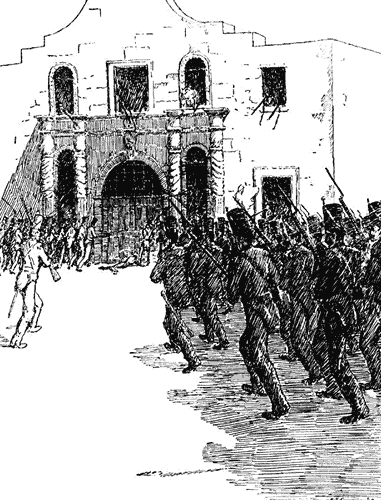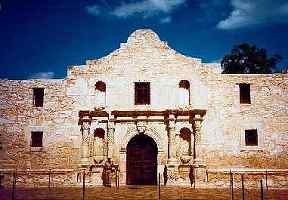|
|
| Susannah
Wilkerson, of Hardeman County, Tennessee, married Almeron Dickinson
at the age of fifteen. Stories tell how Susannah and Almeron were
sweethearts but a spat caused Almeron to court another girl who just
happened to be a friend of Susannahís. To make matters worse, Susannahís
friend asked her to be a bridesmaid at her wedding to Almeron! In
her heart, Susannah still pined for Almeron and soon she and Almeron
realized that they still loved each other so the night before his
wedding to the other woman they saddled their horses and rode away
leaving a very bewildered bride standing at the altar. The newly-weds
joined a group of colonists and found themselves on their way to a
faraway place called Texas. |
|
|
Susannah
Dickinson
Photo courtesy Linda Kirkpatrick |
| |
The
families who arrived in Texas as part
of Austinís ďOriginal Three HundredĒ, found various ways to deal with
the hardships of this new land. This particular bunch settled in a
community called, Gonzales.
They received various assistance from the Mexican Comandante
at Bexar. The Mexicans gave the people of the community of
Gonzales a cannon
to aid in the defense of Indian attacks. Who would have ever guessed
that the almost worthless gun would be such an important part of Texas
history?
Susannah and Almeron settled in this community too. Almeron brought
his much in demand blacksmithing skills to the area. On the morning
of October, 1835, the Gonzales
volunteers headed to the defense of Bexar with Almeron as artillery
commander. This body of volunteers consisted of five to six hundred
men.
During the siege of Bexar, the Gonzales
Volunteers found many Mexican women and children hiding in the homes.
These women like the Anglo women, showed strength unheard of today.
They offered food and cared for the wounded from both sides of the
battle.
The siege of Bexar ended on December 10, 1835. Some of the volunteers
returned to their homes weary and tired but jubilant over their victory.
They would soon return to the area of Bexar. Almeron was one of the
volunteers that returned to Gonzales.
On his second trip, he took Susannah and their baby daughter, Angelina.
They set up housekeeping at the home of Ramon Musquiz on Main Plaza.
They lived here until the day that the bells tolled, signaling the
coming of the Mexican armies.
The
ringing of the bells at the Church of San Fernando alerted the people
of the community of Bexar that danger was near. Susannah grabbed Angelina
and ran towards the plaza for more information. Almeron met them there.
The three quickly loaded on the back of his horse and galloped to
the protective gates of San Antonio de Valero, the Alamo.
After their arrival at this old abandoned structure, they were soon
followed a small group of volunteers that numbered less than two hundred.
For thirteen days they made their stand against the Mexican forces
that numbered in the thousands. |
 |
The situation
inside the walls of the Alamo
became disheartening. They waited and waited for help that never arrived.
On the thirteenth day of the Mexican surge, in the early morning hours
of March 6, 1836, Susannah and the rest of the inhabitants heard the
haunting notes of the trumpet song, Deguello. As the final
note traversed the morning air, Santa Anna, charged the walls for
one last time.
Soon there was silence. Susannah and the other non-combatants, mostly
Mexican women and their children, huddled with their children in a
corner room wondering what their fate would be. A Mexican officer
entered the room. He looked at Susannah and told her that if she wanted
to save her life and that of Angelina that she must follow him.
Susannah picked up Angelina and followed the officer into the courtyard.
It was then that she viewed a site that history books can never describe.
The air was still and there was a deafening hush all around. The bodies
of the brave dead Texans lay stacked in piles, later to become funeral
pyres spreading smoke and history to the sky above.
Susannah
learned that she would be the courier of the news to Sam
Houston. The trip from the Alamo
to Gonzales would
take this sad group three to four days. It was only about 75 miles
but what was the rush? It was from lips of Susannah that Houston heard
the fate of the Alamo.
In the panic to flee the tyrant Santa Anna, Susannah and the baby
were loaded into a cart and would again take part in another important
historical event, the Runaway
Scrape.
Life for Susannah went from bad to worse in the years after
the fall of the Alamo. She found herself as a widow with a baby
in the wilds of Texas. She was destitute
and possibly turned to a trade that managed to support some women
left in this situation.
After three failed marriages she became the bride of Joseph William
Hannig. For the first time since her marriage to Almeron Dickenson,
she was happy and secure. It is said that she only visited the Alamo
once after her departure in 1836. I guess that is understandable.
She didnít share a lot about her time spent in the Alamo
or her life after the fall. I guess she didnít realize how important
her story would be.
Susannah died on October 7, 1883 at the age of 68. She is buried in
Austin, Texas in Oakwood
Cemetery. She could have added a lot to the romance
of the Alamo, but she didnít. |
 |
|
|
